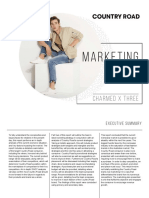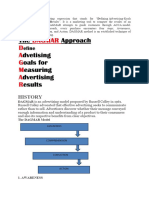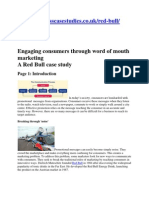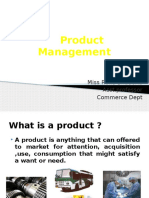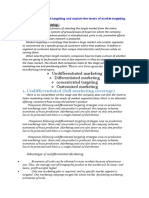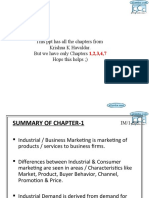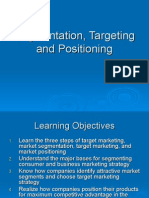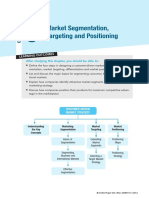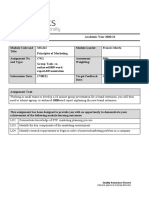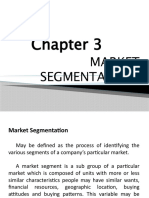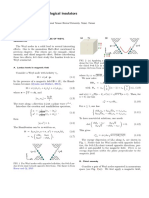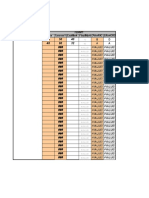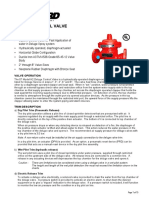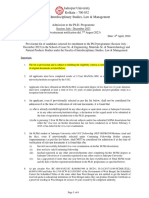Customer-Driven Marketing Strategy: Creating Value for Target Customers
Topic Outline
Market Segmentation
Market Targeting
Differentiation and Positioning
�Market Segmentation
-is the process that companies use to divide large heterogeneous markets into small markets that can be reached more efficiently and effectively with products and services that match their unique needs
�Market Segmentation
�Market Segmentation
Segmenting Consumer Markets
Geographic segmentation
Demographic segmentation
Psychographic segmentation
Behavioral segmentation
�MAJOR SEGMENTATION VARIABLES FOR CONSUMER MARKETS
Geographic segmentation
- divides the market into different geographical units such as nations, regions, states, counties, or cities
�MAJOR SEGMENTATION VARIABLES FOR CONSUMER MARKETS
Demographic segmentation divides the market into groups based on variables such as age, gender, family size, family life cycle, income, occupation, education, religion, race, generation, and nationality
�DEMOGRAPHIC SEGMENTATION
Age and life-cycle stage segmentation is the process of offering different products or using different marketing approaches for different age and life-cycle groups.
Gender segmentation divides the market based on sex (male or female)
�Demographic Segmentation
Income segmentation divides the market into affluent or low-income consumers
�MAJOR SEGMENTATION VARIABLES FOR CONSUMER MARKETS
Psychographic segmentation
- divides buyers into different groups based on social class, lifestyle, or personality traits
�MAJOR SEGMENTATION VARIABLES FOR CONSUMER MARKETS
BEHAVIORAL SEGMENTATION
�Behavioral Segmentation
- divides buyers into groups based on their knowledge,
attitudes, uses, or responses to a product.
-divides a population based on their behavior, the way
the population respond to, use or know of a product.
�Forms of Behavioral Segmentation:
OCCASIONS.
Buyers can be grouped according to occasions when they get the idea to buy, actually make their purchase , or use the purchase item.
Occasion Segmentation -dividing the market into groups according to occasions when buyers get the idea to buy, actually make their purchase, or used the purchased item.
�Forms of Behavioral Segmentation:
BENEFIT
SOUGHT. A powerful form of segmentation is to group buyers according to the different benefits that they seek from the product.
Benefit Segmentation -the process of grouping customers into market segments according to the benefits they seek from the product. -Summers et al. (2009, p. 142)
�Forms of Behavioral Segmentation:
USER STATUS
Markets can be segmented into nonusers, ex-users, potential users, first time users, and regular users of a product. Marketers want to reinforce and retain regular users,
attract targeted nonusers, and reinvigorate relationships
with ex-users.
�Forms of Behavioral Segmentation:
USAGE RATE
Markets can also be segmented into light,
medium and heavy product users.
�Forms of Behavioral Segmentation:
LOYALTY STATUS
A market can also be segmented by consumer loyalty.
Loyal consumers - those who buy one brand all or most of the time - are valuable customers.
�Buyers can be divided into four groups according to their brand-loyalty status:
Hard-core loyals - consumers who buy one
brand all the time.
Split loyals consumers who are loyal to two
or three brands.
�Buyers can be divided into four groups according to their brand-loyalty status:
Shifting loyals consumers who shift from
favoring one brand to another.
Switchers consumers who show no loyalty
to any brand.
�Forms of Behavioral Segmentation:
BUYER-READINESS STAGE
A market consists of people in different buyer-readiness stages of readiness to buy a product. Some people are unaware of the product; some are aware; some are informed; some are interested; some want the product; and some intend to buy.
� Buyer readiness stages range from being unaware that the
product or service exists to actual purchase. The six buyer readiness stages are:
Issues
Stage
Awareness
Is the consumer aware that the product exists? Do they know about your company and your brand?
Knowledge
What does the consumer need to know about the product? Do they know what benefits the product provides? Do they know what attributes/features the product has? Do they know how much the product costs and where to buy it?
Liking
Does the consumer like the product? What is their attitude towards the product? Do they feel that it would provide useful benefits?
Preference
Does the consumer prefer your brand? Do they believe that your brand provides the right mix of attributes to deliver desired benefits?
Conviction
Is the consumer convinced that they should buy your brand? Are they convinced that your brand would meet their needs and is value for money? Have they moved from purchase intention to actually purchasing the product?
Purchase
�Forms of Behavioral Segmentation:
ATTITUDE TOWARDS PRODUCT
Attitude is a learned tendency to respond
consistently towards a given object.
People in a market can be enthusiastic, positive,
indifferent, negative or hostile about a product.
�The Strategic Directions Group found the following types of people:
1. Upbeat enjoyers feel that the best years are now
and in the future.
2. Insecures feel that they havent been successful
in life and the best years are over.
�The Strategic Directions Group found the following types of people:
3. Threatened actives worry about crime but have
a more positive outlook on life.
4. Financial positives are more open to change and
more concerned about looking good.
�SEGMENTING BUSINESS MARKETS
Segmenting a business market means dividing the market into different homogenous groups of
companies. Such organizations are considered as one segment and are catered according to their needs.
�SEGMENTING INTERNATIONAL MARKETS
Companies can segment international markets using one or a combination of several variables. They can segment by geographical location. World markets can also be segmented on the basis of economic factors. Countries can be segmented by political and legal factors. Cultural factors can also be used, grouping markets according to common languages, religions, values and attitudes, customs, and behavioral patterns.
�SEGMENTING INTERNATIONAL MARKETS
Intermarket Segmentation
- forming segments of consumers who have similar needs and buying behavior even though they are located in different countries.
��REQUIREMENTS FOR EFFECTIVE SEGMENTATION
MEASURABLE:
The size, purchasing power, and profiles
of the segments can be measured.
ACCESSIBLE:
The market segments can be effectively
reached and served.
SUBSTANTIAL:
The market segments are large or
profitable enough to serve.
�REQUIREMENTS FOR EFFECTIVE SEGMENTATION
DIFFERENTIABLE:
The segments are conceptually
distinguishable and respond differently to different marketing mix elements and programs.
ACTIONABLE: Effective programs can be designed for
attracting and serving the segments.
��Market Targeting
the process of evaluating each market segments
attractiveness and selecting one or more segments to enter. It requires carefully understanding consumer wants and needs, as well as having a good grasp on how a given product or service can meet those consumer desires.
�Evaluating Market Segments
In evaluating different market segments, a firm must
look at three factors:
Segment size and growth Segment structural attractiveness. Major structural
factors that affect long-run segment attractiveness:
Competitors Substitute products Power of buyers Powerful suppliers
Company objectives and resources
�Selecting Target Market Segments
Target Market
set of buyers who share common needs or characteristics that the company decides to serve Targeting
Can be carried out at several different levels.
Companies can target very broadly, very narrowly, or
somewhere in between.
�Selecting Target Market Segments
Undifferentiated Marketing Defined as a market-coverage strategy in which a firm decides to ignore market segment differences and go after a whole market with one offer. Focuses on what is common needs of consumers rather than what is different. Treats all potential buyer as a homogeneous group.
�Selecting Target Market Segments
Differentiated Marketing Strategy in which firma targets several market segments and design separate offers for each. Developing strong market positions within several market segments. Increases the cost of doing business:
Extra marketing research, forecasting, sales analysis, promotion planning, and channel development.
�Selecting Target Market Segments
Concentrated Marketing The firm goes after a large share of one or a few segments or niches Strong market position:
It can market more effectively and more efficiently
Niches are smaller and may attract only one or a few
competitors. Highly profitable and at the same time, it involves higher-than-normal risks.
�IV. Micromarketing
Local Marketing- tailoring brands & promotions to the needs & wants of local customer groupscities, neighborhoods, specific stores.
�Individual Marketingtailoring products & marketing programs to the needs & preferences of individuals.
�Factors in choosing a Targeting Strategy:
Company resources Degree of product variability Products life-cycle stage Market variability Competitors marketing strategy
�Socially Responsible Target Marketing Focusing on the segments that they can satisfy best and most profitably.
��PRODUCT POSITION
the way the product is defined by consumers on important attributes-the place the product occupies in consumers minds relative to competing products.
�POSITIONING MAPS
PERCEPTUAL POSITIONONG MAPS
which show consumer perceptions of their brands versus competing products on important buying dimensions.
�CHOOSING A DIFFERENTIATION AND POSITIONING STRATEGY
1. Identifying possible value differences and competitive advantages. 2. Choosing the right competitive advantages 3. Selecting an overall positioning strategy
�Competitive advantage
an advantage over competitors gained by offering greater customer value, either through lower prices or providing more benefits that justify higher prices.
�Points of differentiation
Product
Services
Channels
People Image
�Product
brands can be differentiated on features, performance, or style and design.
Services
through speedy, convenient or careful delivery.
�Channel
gain competitive advantage through the way they design their channels coverage, expertise and performance.
People
hiring and training other people than their competitors do.
Image
brand image should convey the products distinctive benefit sand positioning.
�2.
How many differences to promote
Which differences to promote
Important
Distinctive
Superior Communicable
Preemptive
Affordable Profitable
�Selecting an Overall Positioning Strategy
Full positioning of the brand is called the brands value
proposition. Potential value propositions include:
More for More More for the Same The Same for Less Less for Much Less
More for Less
�Developing a Positioning Statement
Summing up the company and brand positioning is
called positioning statement. It takes the form: To (target segment and need) our (brand) is (concept) that (point of difference).
�Communicating and Delivering the Chosen Position
Company must take strong steps to deliver and
communicate the desired position to target consumers. The marketing mix efforts must support the positioning strategy. Must monitor and adapt the position over time to match changes in consumer needs and competitors strategies.






